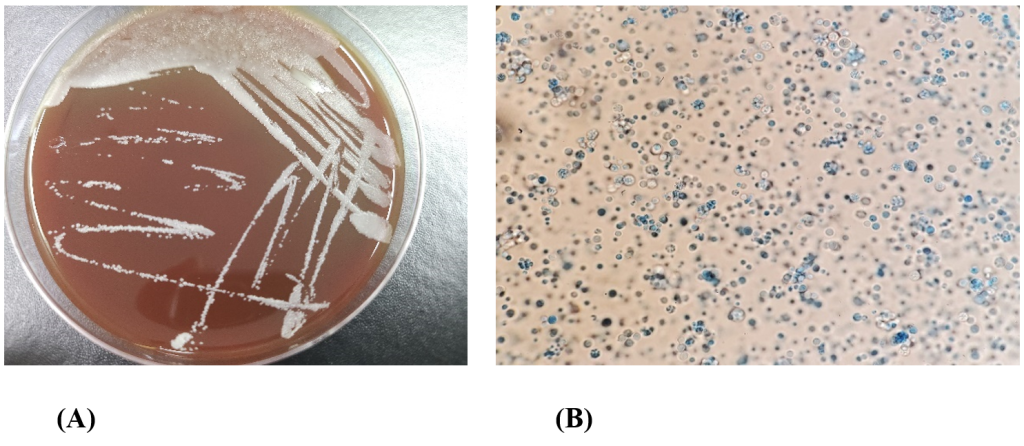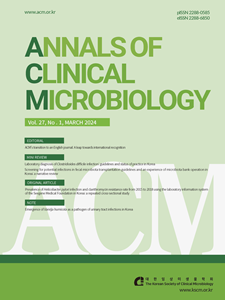Cutaneous infection caused by Prototheca wickerhamii identified using VITEK MS following pretreatment with a mold-extraction protocol: a case report

Case report Dong Heon Shin, Joon Kim, Wee Gyo Lee Departments of Laboratory Medicine, Ajou University School of Medicine, Suwon, Korea Corresponding to Wee Gyo Lee, E-mail: weegyo@ajou.ac.kr Ann Clin Microbiol 2024;27(4):271-277. https://doi.org/10.5145/ACM.2024.27.4.7Received on 2 October 2024, Revised on 3 November 2024, Accepted on 11 November 2024, Published on 3 December 2024.Copyright © Korean Society […]
Fig. 1. A sample positive for both Mycoplasma hominis (Mh) and Ureaplasma species (Up) resulted in ≥ 104 color-changing units for Mh and Uh using a Mycoplasma IST2 assay kit (A) and Mycoplasma IST3 assay kit (B), respectively. The results showed that the minimum inhibitory concentrations (MIC) of ofloxacin were 4 μg/mL, ciprofloxacin > 2 μg/mL, and for erythromycin > 8 μg/mL with the Mycoplasma IST2 kit. The MIC values for levofloxacin and moxifloxacin were ≤ 2 μg/mL, and > 8 μg/mL for erythromycin with Up. The MIC values for levofloxacin were > 2 μg/mL, moxifloxacin > 0.5 μg/mL, and clindamycin > 0.5 μg/mL for Mh with the Mycoplasma IST3 kit.
Ann Clin Microbiol 2024;27(3):205-214. Verification of the Mycoplasma IST3 for urogenital mycoplasma culture in comparison to the Mycoplasma IST2 Download image
Table 3. Summary of the mismatch results for fluoroquinolone susceptibility for 34 Ureaplasma species-positive samples using the Mycoplasma IST2 and IST3 kits
Ann Clin Microbiol 2024;27(3):205-214. Verification of the Mycoplasma IST3 for urogenital mycoplasma culture in comparison to the Mycoplasma IST2 Download table Specimen No. Fluoroquinolone MIC (μg/mL) Ofloxacin Ciprofloxacin Levofloxacin Moxifloxacin 8 4 > 2 ≤ 2 ≤ 2 10 4 > 2 ≤ 2 ≤ 2 17 4 > 2 ≤ 2 ≤ 2 19 […]
Table 2. Cumulative antimicrobial susceptibility of Mycoplasma hominis and Ureaplasma species tested using the Mycoplasma IST2 and Mycoplasma IST3 kits
Ann Clin Microbiol 2024;27(3):205-214. Verification of the Mycoplasma IST3 for urogenital mycoplasma culture in comparison to the Mycoplasma IST2 Download table IST2 Antimicrobials % Susceptibility IST3 Antimicrobials % Susceptibility Mh+ (n=12) Up (n=35) Mh (n=5) Up (n=42) Ofloxacin 8.3 17.1 Levofloxacin 60.0 64.3 Ciprofloxacin 8.3 2.8 Moxifloxacin 60.0 97.6 Doxycycline 91.6 91.4 Clindamycin 60.0 – […]
Table 1. Evaluation of the performance of the Mycoplasma IST3 kit for analysis of speciation and enumeration of genital mycoplasmas compared to the Mycoplasma IST2 kit
Ann Clin Microbiol 2024;27(3):205-214. Verification of the Mycoplasma IST3 for urogenital mycoplasma culture in comparison to the Mycoplasma IST2 Download table CCU by Mycoplasma IST2 CCU by Mycoplasma IST3 Up ≥ 106 Up ≥ 104 Mh ≥ 104 & Up ≥104 Mh < 104 & Up ≥104 Up ≥ 103 Up < 103 Mh ≥ […]
Fig. 2. Weekly comparison analysis showing the epidemiological trend of Candida infection between 2012 and 2022.
Ann Clin Microbiol 2024;27(3):185-196. Seasonality and epidemiological trends in species distribution and antifungal susceptibility of Candida species isolated from various clinical specimens conducted during 2011–2022, Korea: a retrospective surveillance study Download image
Fig. 1. Yearly analysis showing the number of Candida, including C. albicans, NAC, particularly C. tropicalis, C. glabrata, and C. parapsilosis, the three most predominant species of NAC. The Candida positivity rate gradually increased from 2012 (465 positive cases out of 55,448, 0.84%) to 2022 (1,164 positive cases out of 65,685 cases, 1.77%). C. albicans and NAC showed the same pattern. NAC, non-albicans Candida.
Ann Clin Microbiol 2024;27(3):185-196. Seasonality and epidemiological trends in species distribution and antifungal susceptibility of Candida species isolated from various clinical specimens conducted during 2011–2022, Korea: a retrospective surveillance study Download image
Table 3. Yearly comparison analysis showing the epidemiological trend of Candida infection between 2012 and 2022
Ann Clin Microbiol 2024;27(3):185-196. Seasonality and epidemiological trends in species distribution and antifungal susceptibility of Candida species isolated from various clinical specimens conducted during 2011–2022, Korea: a retrospective surveillance study Download table Candida infection 2012 2013 2014 2015 2016 2017 2018 2019 2020 2021 2022 2012-2022 Candida spp. 465 401 414 615 794 550 802 […]
Table 2. Species distribution of Candida isolates from sterile and nonsterile clinical specimens
Ann Clin Microbiol 2024;27(3):185-196. Seasonality and epidemiological trends in species distribution and antifungal susceptibility of Candida species isolated from various clinical specimens conducted during 2011–2022, Korea: a retrospective surveillance study Download table Species Respiratory Pus/Wound Urine Stool Tissue Vaginal discharge Cath tip Non-sterile Total Blood Ascitic fluid Pleural fluid Other sterile fluidb Sterile Total Sterile […]
Table 1. Antifungal susceptibilities of 8,760 Candida isolates from clinical specimens determined using the VITEK AST-YS07,08 card
Ann Clin Microbiol 2024;27(3):185-196. Seasonality and epidemiological trends in species distribution and antifungal susceptibility of Candida species isolated from various clinical specimens conducted during 2011–2022, Korea: a retrospective surveillance study Download table Species No. of isolates Antifungal agent MIC (µg/mL) Range % of MICs by category S I/SDD R C. albicans 4226 Amphotericin B ≤0.25-8 […]
